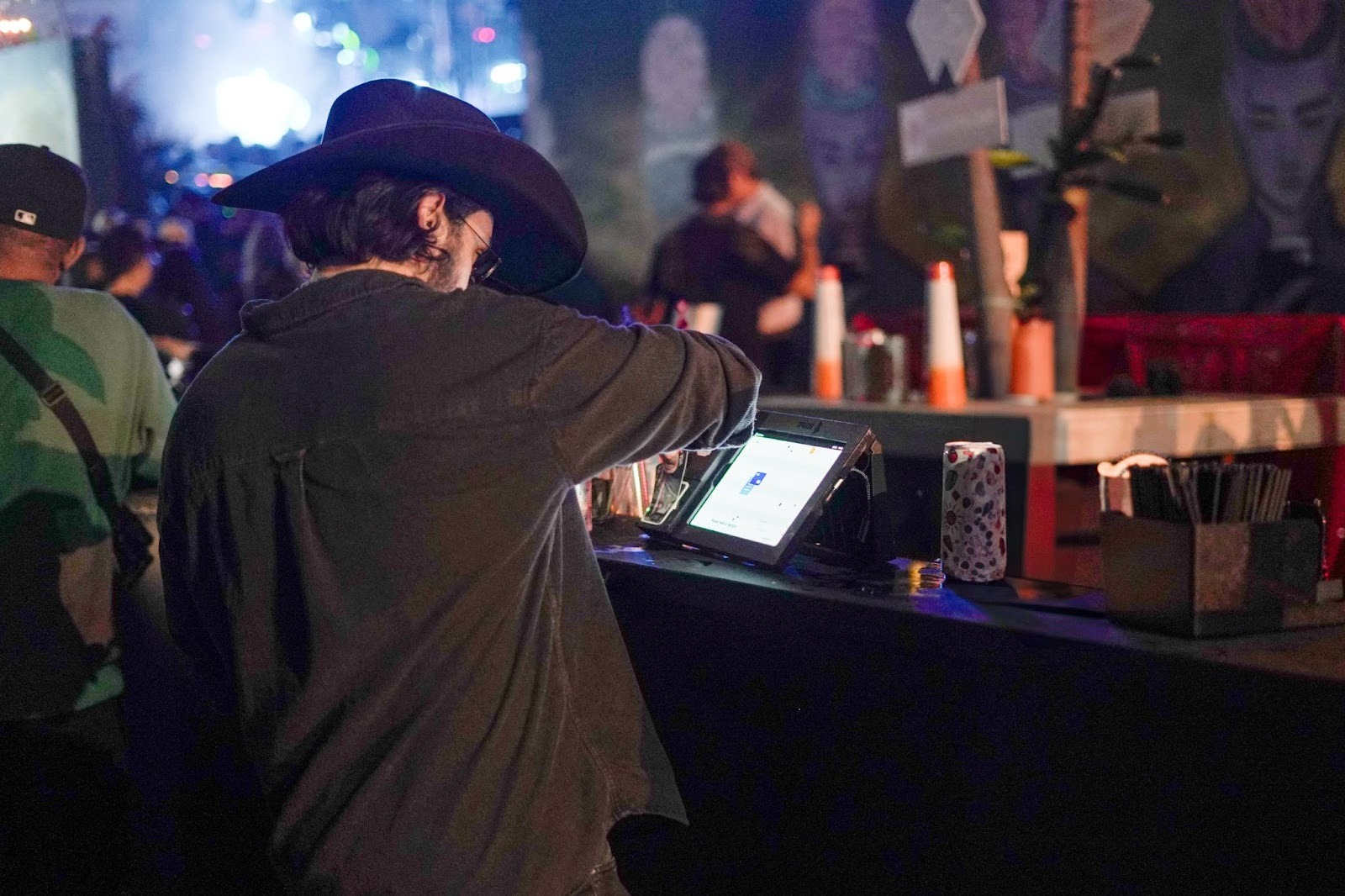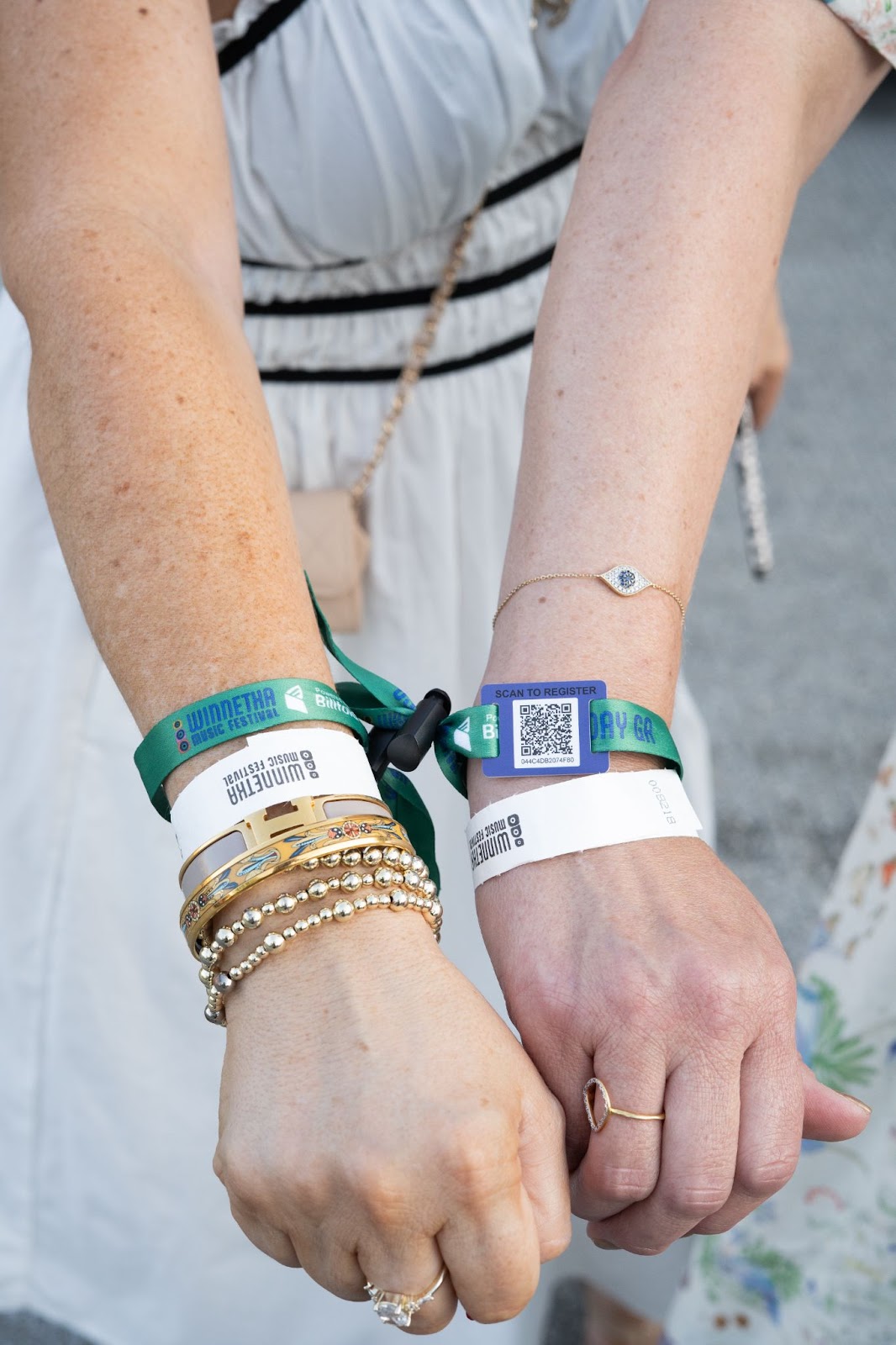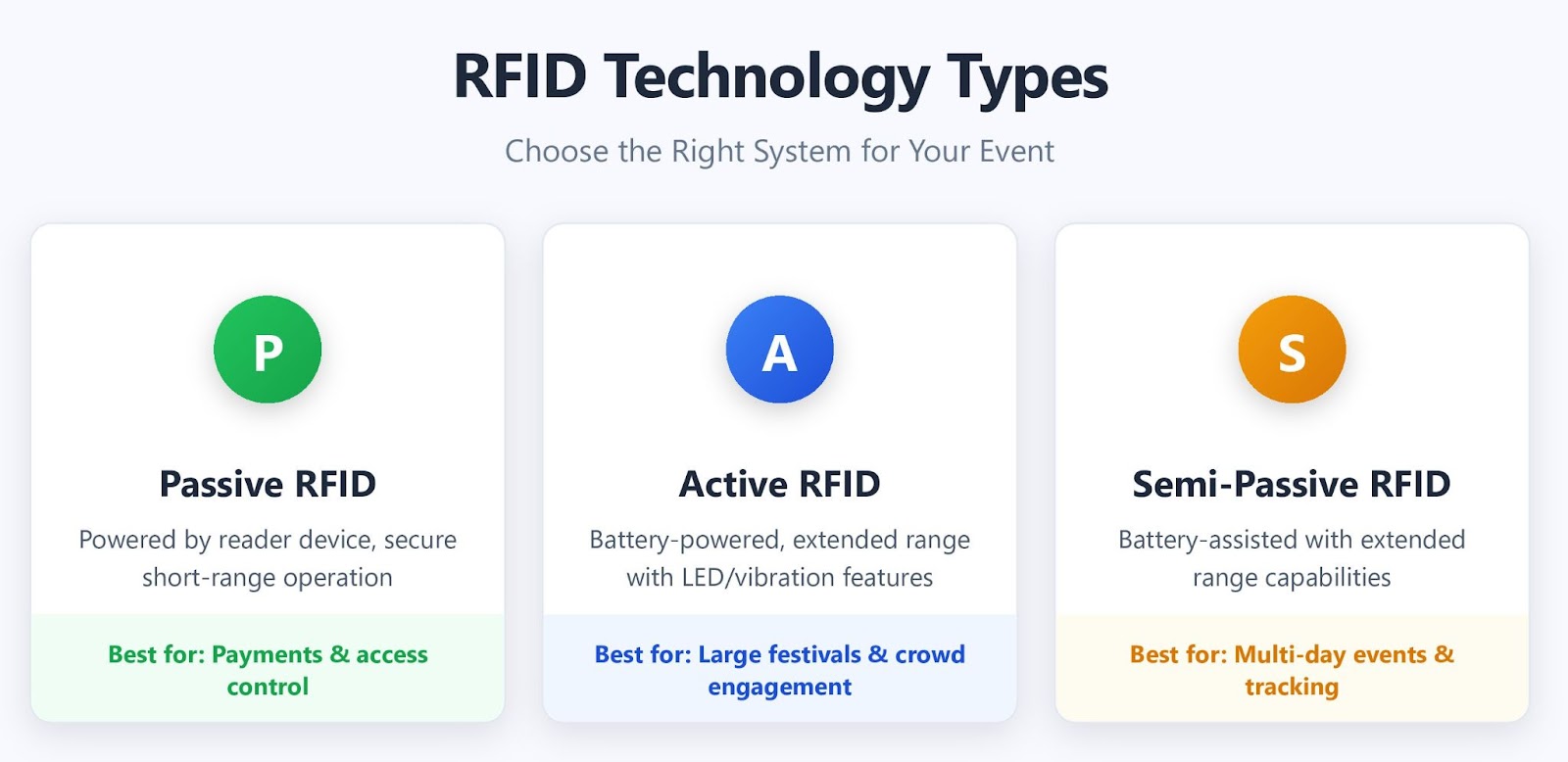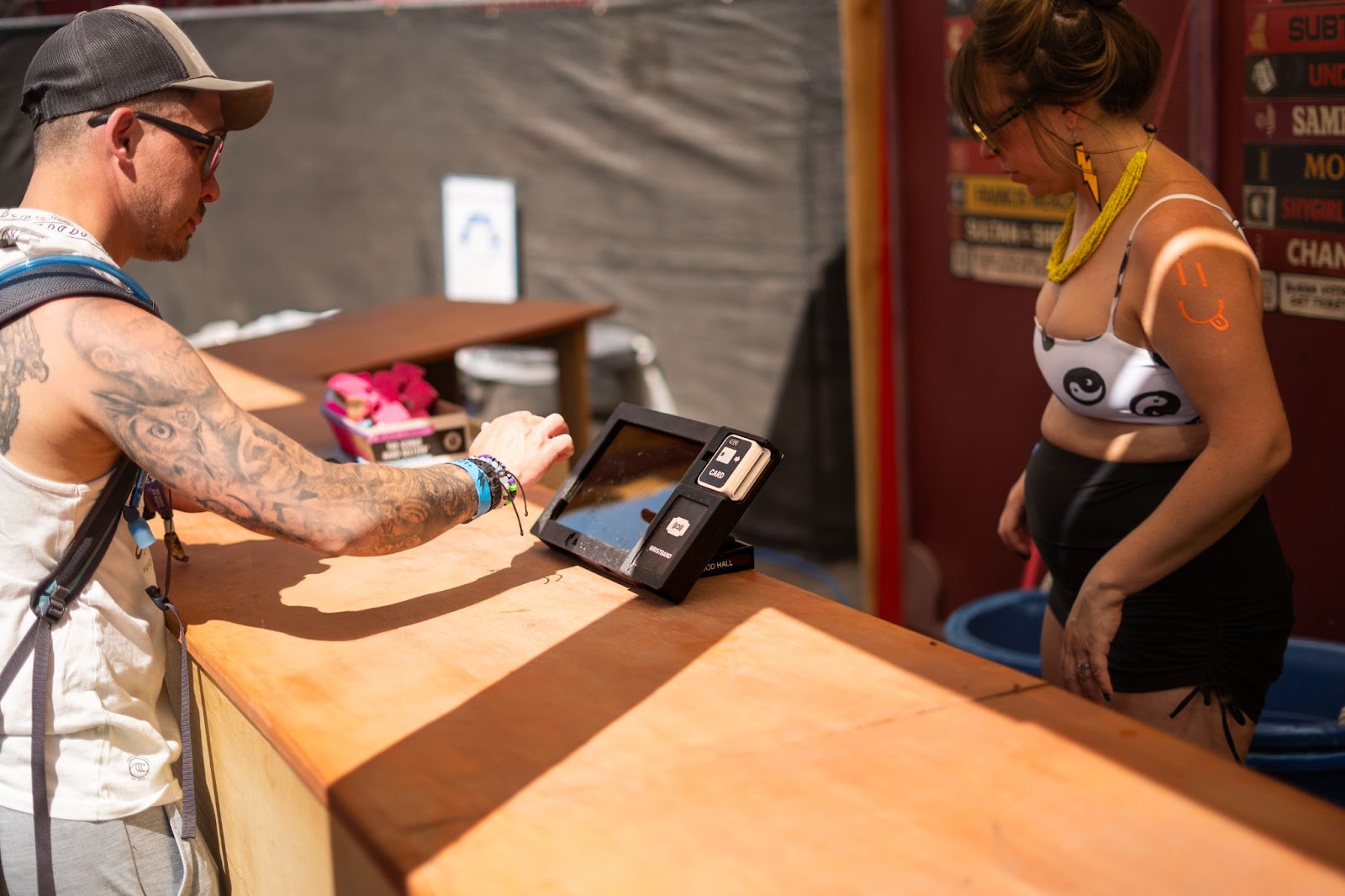RFID Wristbands for Events: 2026 Guide to Cashless Event Tech

Key Takeaways
RFID wristbands for events have evolved into mission-critical infrastructure that transforms revenue, security, and attendee experiences across all event types.
- Explosive market growth: Global RFID market continues rapid expansion with event applications driving significant adoption across all venue types
- Proven financial impact: Events implementing RFID event solutions report substantial revenue increases through faster transactions and optimized operations
- Universal compatibility: From intimate corporate gatherings to massive festivals, RFID cashless systems work seamlessly across all event scales and venues
- 2026 advantage: Smart organizers leverage AI-enhanced RFID analytics for predictive crowd management and personalized attendee experiences
The reality: RFID wristbands don't just act as payment devices, rather, they're comprehensive event platforms that unlock revenue, enhance security, and deliver unforgettable experiences that drive long-term attendee loyalty.
Event technology reached a transformative milestone in 2025 where attendee expectations permanently shifted toward seamless, instant interactions. Traditional payment methods now feel archaic compared to the lightning-fast convenience of RFID wristbands that process transactions in milliseconds while capturing valuable behavioral data.
Recent industry analysis from Precedence Research shows the global RFID market continues its explosive growth trajectory, with event industry adoption driving significant expansion. This unprecedented growth reflects widespread recognition that RFID wristbands for events deliver measurable improvements in revenue generation, operational efficiency, and attendee satisfaction across every event category.
How Are RFID Wristbands Transforming Events in 2026?
What Makes RFID Event Technology Revolutionary?
RFID wristbands represent sophisticated radio frequency identification technology embedded within comfortable, durable wearable formats. These devices contain advanced microchips and antennas that communicate wirelessly with specialized readers, enabling instant data transmission for payments, access control, real-time tracking, and personalized experiences.
The technology operates through electromagnetic induction, where RFID readers emit precise radio waves that power passive chips embedded in wristbands. This energy transfer occurs within milliseconds, allowing attendees to complete complex transactions or gain multi-level access with simple wrist taps. Modern RFID payment technology stores encrypted payment information, access credentials, loyalty data, and attendee preferences while maintaining bank-level security protocols.
Three distinct RFID wristband technologies serve different event requirements based on scale, duration, and engagement objectives. Passive RFID wristbands draw power from reader devices and provide optimal security for payment applications with controlled interaction ranges that ensure privacy while maintaining cost efficiency for large-scale deployments.
Active RFID wristbands contain internal batteries enabling extended communication ranges plus premium features like LED displays, vibration alerts, and two-way communication capabilities. These solutions suit major festivals where crowd engagement, emergency communications, and real-time interaction enhance safety and experience quality.
Semi-passive RFID wristbands combine battery assistance with reader-powered functionality, extending operational range while maintaining cost efficiency. These hybrid solutions work exceptionally well for multi-day events requiring both instant payment processing and long-range tracking capabilities for crowd management.

What Revolutionary Benefits Do RFID Wristbands Deliver in 2026?
Modern RFID cashless systems transform event operations by eliminating traditional payment friction while generating unprecedented operational intelligence. Every transaction creates rich data points revealing attendee behavior patterns, product preferences, traffic flow dynamics, and peak activity periods that enable real-time optimization strategies.
Industry analysis consistently shows that events implementing RFID systems experience transformational improvements in both financial performance and operational efficiency. Transaction processing accelerates significantly compared to traditional methods, while comprehensive tracking capabilities eliminate revenue leakage from cash handling errors and provide granular insights for strategic decision-making.
Security enhancements represent another critical advancement area. RFID event security systems eliminate cash theft risks while providing complete transaction audit trails with tamper-evident technology. Advanced encryption protocols protect sensitive payment data using bank-grade security standards, while unique device identifiers prevent counterfeiting and unauthorized access attempts with near-100% effectiveness.
Revolutionary New Use Cases for RFID Event Solutions in 2026
AI-Powered Crowd Management and Safety
Event organizers in 2026 leverage AI-enhanced RFID systems for predictive crowd management that prevents dangerous bottlenecks before they occur. Real-time attendee positioning data feeds machine learning algorithms that predict crowd density patterns, enabling proactive staff deployment and emergency response optimization.
Smart venue operators use RFID tracking data to identify optimal evacuation routes, detect overcrowding in specific zones, and automatically redirect foot traffic through dynamic signage integration. This technology proved invaluable during major 2025 festivals where predictive analytics prevented multiple potential safety incidents.

Personalized Marketing and Experience Customization
Advanced RFID analytics enable unprecedented personalization capabilities that transform attendee experiences. Event organizers track individual movement patterns, purchase histories, and engagement preferences to deliver targeted recommendations, exclusive offers, and customized content throughout the event experience.
Leading festivals now use RFID data to create personalized mobile app experiences, recommend food vendors based on dietary preferences, suggest optimal viewing locations for preferred artists, and provide real-time queue length information for popular attractions.
Sustainability and Environmental Impact Tracking
Environmental consciousness drives new RFID applications focused on sustainability measurement and waste reduction. Events track individual carbon footprints through RFID data, gamify eco-friendly behaviors with rewards systems, and provide real-time environmental impact dashboards for attendees.
Progressive organizers implement RFID-enabled reusable cup programs, waste sorting verification systems, and carbon offset purchasing integration that transforms sustainability from abstract concept to measurable, actionable data.
Hybrid Event Integration and Virtual Connectivity
RFID wristbands now bridge physical and virtual event experiences through seamless integration with live streaming platforms, virtual reality components, and remote attendee engagement systems. Physical attendees can instantly share content with virtual participants, unlock exclusive digital content, and participate in global event experiences that extend far beyond venue boundaries.
This hybrid approach enables events to generate additional revenue streams through virtual merchandise sales, digital experience packages, and global participation options that multiply audience reach potential.
8 Game-Changing Benefits of RFID Wristbands for Events
1. Lightning-Fast Transaction Processing
RFID wristbands complete transactions in under 1.5 seconds compared to 15-30 seconds for traditional payment methods. This speed improvement dramatically reduces queue times, allowing attendees to maximize enjoyment time while encouraging impulse purchases through frictionless interactions.
2. Dramatic Revenue Increases
Events implementing comprehensive RFID systems report substantial revenue improvements through multiple optimization factors. Increased transaction frequency, higher per-purchase amounts, elimination of cash handling losses, and enhanced operational efficiency combine to deliver significant financial improvements that justify technology investments within single events.
3. Advanced Security and Fraud Prevention
Military-grade encryption and unique identifiers make RFID wristbands virtually impossible to counterfeit using conventional methods. Complete elimination of cash handling dramatically reduces theft risks while comprehensive transaction logs provide forensic-level audit trails for financial accountability and fraud investigation.
4. Real-Time Operational Intelligence
Every RFID interaction generates valuable business intelligence about attendee behavior, product performance, traffic patterns, and operational bottlenecks. This data enables dynamic inventory management, optimized staffing deployment, surge pricing strategies, and evidence-based decisions that improve profitability while enhancing attendee experiences.
5. Streamlined Access Control and Security
RFID-enabled entry points process attendees significantly faster than traditional ticket validation methods while providing enhanced security through real-time verification. Multiple access levels can be programmed into single wristbands, enabling VIP areas, age verification, special events, and staff zones without additional credentials or manual verification.
6. Enhanced Attendee Experience and Satisfaction
Contactless interactions feel modern and convenient while eliminating common frustrations like lost tickets, forgotten wallets, or payment delays. Attendees appreciate the simplicity and security of wrist-tap payments that keep personal items safe while enabling seamless movement throughout event spaces.
7. Reduced Operational Costs and Complexity
Automated systems significantly reduce labor requirements while eliminating cash handling costs, reconciliation errors, and administrative overhead. Detailed reporting capabilities streamline accounting processes, reduce audit complexity, and provide actionable insights that improve operational efficiency across all event functions.
8. Environmental Sustainability and Social Responsibility
Digital transactions eliminate paper tickets and cash handling materials while enabling comprehensive recycling programs. Many RFID wristbands use sustainable materials, biodegradable components, and reusable designs that align with environmental responsibility initiatives while appealing to eco-conscious attendees.

How Do You Successfully Implement RFID Wristbands for Your 2026 Event?
Successful RFID implementation requires systematic planning addressing technology selection, staff training, attendee communication, and integration with existing event management systems. Begin comprehensive assessment of event requirements including attendee projections, venue layout complexity, payment volume estimates, and integration needs with ticketing, security, and analytics platforms.
Technology partner selection proves critical for implementation success and long-term operational efficiency. Choose providers with extensive event industry experience offering comprehensive support including hardware provisioning, software integration, staff training programs, and 24/7 technical assistance during events. Reliable RFID payment technology requires robust backend systems capable of handling peak transaction volumes without performance degradation or system failures.
Staff training should commence at least three weeks before events to ensure comfortable operation and rapid troubleshooting capabilities. Create comprehensive reference materials addressing common scenarios, technical issues, and customer service situations. Well-trained staff can effectively communicate system benefits to attendees while resolving minor problems quickly and professionally.
Attendee communication strategies significantly impact adoption rates and overall satisfaction levels. Implement clear pre-event messaging explaining RFID benefits, activation procedures, usage instructions, and troubleshooting guidance. On-site signage, demonstration stations, and proactive staff assistance help attendees understand technology quickly while building excitement about enhanced event experiences.
Technical infrastructure planning includes strategic reader placement, network connectivity redundancy, and comprehensive backup systems ensuring reliable operation throughout entire events. Consider peak usage scenarios during popular performances or meal periods and plan system capacity accordingly to prevent overloads during high-traffic situations.
What ROI Should You Expect from RFID Event Technology?
Return on investment calculations for RFID systems must consider both direct revenue improvements and operational cost savings across multiple event cycles. Academic research from Applied Sciences journal indicates the widespread adoption of RFID technology across diverse industries, with events showing particularly strong implementation success due to the technology's versatility in real-time tracking and operational optimization.
Direct revenue improvements stem from increased transaction frequency due to convenience, higher per-purchase amounts through impulse buying, reduced revenue leakage from cash handling errors, and optimized pricing strategies based on real-time demand analytics. Industry leaders consistently report substantial increases in per-attendee spending following comprehensive RFID implementation.
Operational cost savings include eliminated cash handling expenses, reduced staff requirements for payment processing, decreased accounting overhead, and minimized fraud losses. These savings compound over multiple events while improving operational efficiency and reducing administrative burden on event management teams.
Long-term value creation through comprehensive attendee data collection enables targeted marketing campaigns, improved event planning decisions, enhanced sponsorship opportunities, and premium experience packages. This intelligence creates sustainable competitive advantages generating ongoing value far beyond immediate transaction improvements.
What's Next for RFID Wristbands and Event Technology?
Emerging technologies enhance RFID capabilities through seamless integration with artificial intelligence, Internet of Things sensors, augmented reality platforms, and blockchain verification systems. These developments enable predictive crowd management, personalized recommendation engines, automated inventory optimization, and immersive digital experiences that transform attendee engagement.
Market expansion accelerates across event types and geographic regions as costs decrease and capabilities improve dramatically. Research from IEEE RFID Technical Applications Conference demonstrates continued robust growth in RFID technology adoption, driven primarily by event industry adoption and continuous technological advancement.
Integration opportunities with social media platforms, loyalty programs, customer relationship management systems, and marketing automation tools create comprehensive attendee engagement ecosystems. These connections enable personalized experiences extending beyond individual events while building lasting relationships that drive repeat attendance and brand loyalty.
Sustainability initiatives drive development of completely biodegradable wristband materials, comprehensive recycling programs, and carbon-neutral production processes that align with environmental responsibility goals. These improvements enhance appeal for environmentally conscious event organizers and attendees while meeting increasingly strict sustainability requirements.
Innovation in wearable technology introduces revolutionary form factors and capabilities enhancing comfort, durability, functionality, and aesthetic appeal. Future developments include biometric integration for health monitoring, expanded communication capabilities for emergency situations, and seamless integration with personal devices for ultimate convenience.
Frequently Asked Questions
How much do RFID wristbands cost per attendee in 2026? RFID wristband costs typically range from $2-12 per attendee depending on technology type, customization requirements, order volume, and advanced features. Most events recover these costs through increased revenue and operational savings within the first few hours of operation.
Can attendees receive refunds for unused RFID wristband balances? Yes, modern RFID systems offer multiple convenient refund options including on-site refund stations, online processing portals, mobile app integration, or automatic refunds to original payment methods. Specific policies vary by event organizer and payment processor requirements.
How long do RFID wristbands last and can they be reused across events? RFID wristbands typically maintain functionality for 3-7 years when stored properly and can be reprogrammed for multiple events. However, most events use single-use wristbands for security, branding, and hygiene purposes while implementing recycling programs for environmental responsibility.
What happens if RFID readers malfunction during events? Professional RFID systems include redundant backup readers, multiple network connectivity options, offline transaction capabilities, and hot-swappable hardware ensuring continued operation even if primary systems experience technical issues or power interruptions.
Do RFID wristbands work reliably in all weather conditions? Modern RFID wristbands feature completely waterproof construction and operate reliably in rain, snow, extreme heat, and sub-freezing temperatures. The underlying technology performs consistently across diverse environmental conditions without degradation or failure.
How secure is attendee data collected through RFID systems? RFID systems employ bank-level security including AES encryption, tokenization, secure data transmission protocols, and compliance with PCI DSS standards. Attendee data receives protection equivalent to credit card transactions while maintaining strict privacy controls and regulatory compliance.
Transform Your Next Event with Advanced RFID Technology
RFID wristbands for events represent proven, mature technology delivering measurable improvements in revenue generation, operational efficiency, and attendee satisfaction. The combination of lightning-fast transactions, enhanced security capabilities, and valuable data collection creates compelling value propositions for event organizers seeking competitive advantages in an increasingly sophisticated marketplace.
The evidence overwhelmingly supports RFID adoption for events across all sizes and categories. From intimate corporate gatherings to massive international festivals, organizers consistently report significant improvements in both financial performance and operational efficiency following comprehensive implementation with proper training and support.
As the event industry continues evolving toward seamless, technology-enhanced experiences, RFID wristbands provide essential infrastructure for meeting rising attendee expectations while achieving ambitious business objectives. The technology has matured beyond experimental status to become fundamental event infrastructure that forward-thinking organizers implement strategically.
Ready to revolutionize your event experience with cutting-edge RFID technology? Billfold's comprehensive event RFID payment solutions deliver enterprise-grade capabilities with the reliability, revenue increase, and dedicated support that successful events demand. Contact our expert team to discover how RFID wristbands can transform your next event into an unforgettable experience that attendees will eagerly anticipate returning to again.
What Are RFID Wristbands and How Do They Transform Events?
RFID wristbands for events represent sophisticated radio frequency identification technology embedded in comfortable, wearable formats. These devices contain microchips and antennas that communicate wirelessly with specialized readers, enabling instant data transmission for payments, access control, and attendee tracking. Unlike basic identification wristbands, RFID-enabled versions create comprehensive digital ecosystems that connect every aspect of the event experience.
The technology operates through electromagnetic induction, where RFID readers emit radio waves that power passive chips embedded in wristbands. This power transfer happens within milliseconds, allowing attendees to complete transactions or gain access with simple wrist taps. Modern RFID wristbands store encrypted payment information, access credentials, and attendee preferences, creating personalized experiences while maintaining robust security protocols.
Three distinct RFID wristband technologies serve different event requirements:
Passive RFID wristbands draw power from reader devices and offer optimal security for payment applications. Their limited range ensures controlled interactions while maintaining cost efficiency for large-scale deployments. Most event organizers choose passive systems for their reliability and proven security track record.
Active RFID wristbands contain internal batteries that enable extended communication ranges and additional features like LED displays or vibration alerts. These premium options suit large festivals where crowd engagement and real-time communication enhance the experience, though higher costs limit widespread adoption.
Semi-passive RFID wristbands combine battery assistance with reader-powered functionality, extending range while maintaining cost efficiency. These hybrid solutions work well for multi-day events requiring both payment processing and long-range tracking capabilities.

What Are the Benefits of RFID Wristbands for Events?
How Do RFID Cashless Systems Revolutionize Event Operations?
RFID cashless systems transform event operations by eliminating traditional payment friction while generating valuable operational intelligence. Every transaction creates data points that reveal attendee behavior patterns, popular products, and peak activity periods. This information enables real-time inventory adjustments, dynamic pricing strategies, and targeted marketing campaigns that maximize revenue potential.
The operational transformation extends beyond payments. TF Learn's recent analysis shows that RFID-enabled entry processes significantly reduce wait times while providing enhanced security through encrypted data. This efficiency improvement cascades throughout the event, creating smoother crowd flow and reducing staff workload during peak periods.
Revenue improvements prove equally impressive. TF Learn's festival analysis shows events implementing cashless payment systems typically experience significant increases in event revenue, with transactions completing much faster than cash. The convenience factor eliminates purchase hesitation while comprehensive tracking ensures accurate inventory management and reduces revenue leakage from cash handling errors.
Security enhancements represent another critical advantage. RFID systems eliminate cash theft risks while providing complete transaction audit trails. Advanced encryption protocols protect sensitive payment data, while unique identifiers prevent counterfeiting and unauthorized access attempts.
Which RFID Wristband Technology Is Right for Your Event?

Selecting appropriate RFID wristband technology depends on event size, duration, budget constraints, and desired features. Corporate events and smaller gatherings typically benefit from passive RFID systems that provide reliable payment processing and access control without unnecessary complexity or cost.
Large festivals and multi-day events often justify active RFID investments for enhanced attendee engagement capabilities. These systems support real-time communications, interactive experiences, and sophisticated crowd management tools that create memorable experiences while providing operational advantages.
Budget-conscious organizers should focus on passive RFID solutions that deliver core functionality at accessible price points. Industry analysis indicates that passive systems provide optimal return on investment for most events, while active systems become cost-effective for larger gatherings requiring advanced engagement features.
Implementation complexity varies significantly between systems. Passive RFID deployment requires minimal technical infrastructure and staff training, enabling rapid implementation even for first-time adopters. Active systems demand more sophisticated setup procedures but offer greater customization and functionality options for experienced event organizers.
Why Are Event Organizers Adopting RFID Technology in 2025?
Market momentum behind RFID adoption reflects fundamental shifts in attendee expectations and operational requirements. Precedence Research data shows North American RFID market growth exceeding 12% annually, driven primarily by event industry adoption and proven ROI demonstrations.
Consumer behavior changes accelerate adoption trends. Attendees increasingly expect seamless, contactless interactions that minimize wait times while maximizing engagement opportunities. Traditional cash transactions feel outdated and cumbersome compared to instant RFID interactions that maintain event flow and energy.
Operational pressures also drive adoption decisions. Event organizers face rising labor costs, security concerns, and accountability requirements that RFID systems address comprehensively. Automated transaction processing reduces staffing needs while detailed reporting capabilities satisfy financial auditing and compliance requirements.
Competitive advantages emerge for early adopters who leverage RFID data for strategic improvements. Detailed analytics reveal optimization opportunities that enhance future events while building attendee loyalty through improved experiences. This intelligence creates sustainable competitive advantages that compound over multiple events.
Top 8 Benefits of RFID Wristbands for Events in 2025

1. Lightning-Fast Transaction Processing
RFID wristbands complete transactions in under two seconds, compared to 15-30 seconds for traditional payment methods. TF Learn's 2025 analysis shows this speed improvement reduces queue times by up to 80%, allowing attendees to spend more time enjoying events rather than waiting in lines.
2. Dramatic Revenue Increases
Events implementing RFID systems typically see significant revenue improvements through increased transaction frequency and higher per-purchase amounts. The convenience factor encourages impulse purchases while eliminating the friction that prevents sales, with industry leaders consistently reporting substantial increases in per-attendee spending.
3. Enhanced Security and Fraud Prevention
Advanced encryption and unique identifiers make RFID wristbands virtually impossible to counterfeit. The elimination of cash handling reduces theft risks while comprehensive transaction logs provide complete audit trails for financial accountability.
4. Real-Time Operational Intelligence
Every RFID interaction generates valuable data about attendee behavior, popular products, and traffic patterns. This intelligence enables dynamic inventory management, optimized staffing deployment, and strategic decision-making that improves profitability.
5. Streamlined Entry and Access Control
RFID-enabled entry points significantly accelerate attendee processing compared to traditional ticket validation methods. Multiple access levels can be programmed into single wristbands, enabling VIP areas, age verification, and special events without additional credentials.
6. Improved Attendee Experience
Contactless interactions feel modern and convenient while eliminating common frustrations like lost tickets or forgotten wallets. Attendees appreciate the simplicity and security of wrist-tap payments that keep personal items safe.
7. Reduced Operational Costs
Automated systems reduce labor requirements while eliminating cash handling costs and errors. Detailed reporting capabilities streamline accounting processes and reduce administrative overhead for event organizers.
8. Environmental Sustainability
Digital transactions eliminate paper tickets and cash handling materials while enabling wristband recycling programs. Many RFID wristbands use sustainable materials that align with environmental responsibility initiatives.
How Do You Successfully Implement RFID Wristbands at Your Event?
Successful RFID implementation requires systematic planning that addresses technology selection, staff training, and attendee communication. Begin by assessing event requirements including attendee count, venue layout, payment volume projections, and integration needs with existing systems.
Technology partner selection proves critical for implementation success. Choose providers with proven event industry experience who offer comprehensive support including hardware, software, training, and ongoing technical assistance. Reliable RFID payment technology requires robust backend systems that handle peak transaction volumes without performance degradation.
Staff training should commence weeks before the event to ensure comfortable operation and troubleshooting capabilities. Create simple reference materials that address common scenarios and technical issues. Well-trained staff can explain system benefits to attendees while resolving minor problems quickly.
Attendee communication strategies significantly impact adoption rates and satisfaction levels. Clear pre-event messaging explaining RFID benefits, activation procedures, and usage instructions reduces confusion while building excitement. On-site signage and demonstrations help attendees understand the technology quickly.
Technical infrastructure planning includes reader placement, network connectivity, and backup systems that ensure reliable operation throughout the event. Consider peak usage scenarios and plan capacity accordingly to prevent system overloads during high-traffic periods.

What ROI Can You Expect from RFID Event Technology?
Return on investment calculations for RFID systems must consider both direct revenue improvements and operational cost savings. Verified Market Reports analysis indicates that the wristband market continues expanding rapidly, reflecting positive adoption trends across the event industry.
Direct revenue improvements stem from increased transaction frequency, higher per-purchase amounts, and reduced revenue leakage. Industry analysis consistently shows events report substantial increases in overall revenue following RFID implementation through optimized user experiences and streamlined operations.
Operational cost savings include reduced cash handling expenses, lower staff requirements for payment processing, and decreased accounting overhead. These savings compound over multiple events while improving operational efficiency and reducing administrative burden.
Long-term value creation through attendee data collection enables targeted marketing, improved event planning, and enhanced sponsorship opportunities. This intelligence creates sustainable competitive advantages that generate ongoing value beyond immediate transaction improvements.
Competitive positioning advantages emerge for events offering superior attendee experiences through seamless technology integration. These improvements drive attendee loyalty, positive reviews, and word-of-mouth marketing that supports long-term growth objectives.
How Do RFID Systems Protect Attendee Data and Ensure Compliance?
Modern RFID systems employ bank-level security protocols including advanced encryption, tokenization, and secure data transmission standards. Payment information receives the same protection as traditional credit card transactions while maintaining PCI compliance requirements for financial data handling.
Data privacy protections ensure attendee information remains secure throughout the event lifecycle. Comprehensive security best practices include encrypted data storage, limited access controls, and clear data retention policies that protect attendee privacy while enabling valuable analytics.
Regulatory compliance requirements vary by jurisdiction but typically include financial transaction standards, data protection regulations, and consumer privacy laws. Experienced RFID providers understand these requirements and implement appropriate safeguards to ensure full compliance.
Fraud prevention capabilities include real-time transaction monitoring, suspicious activity detection, and immediate response protocols that protect both attendees and event organizers. These systems identify potential security threats quickly while maintaining seamless operation for legitimate transactions.
Audit trail capabilities provide comprehensive transaction records that satisfy financial reporting requirements while enabling detailed analysis of event performance. These records support accountability requirements while generating insights for future improvements.
What's Next for RFID Wristbands and Event Technology?
Emerging technologies will enhance RFID capabilities through integration with artificial intelligence, Internet of Things sensors, and advanced analytics platforms. These developments will enable predictive crowd management, personalized recommendations, and automated inventory optimization that further improve event operations.
Market expansion continues across event types and geographic regions as costs decrease and capabilities improve. MarketsandMarkets projections indicate the global RFID market will reach $25.24 billion by 2033, driven largely by event industry adoption and technological advancement.
Integration opportunities with social media, loyalty programs, and customer relationship management systems will create comprehensive attendee engagement platforms. These connections enable personalized experiences that extend beyond individual events while building lasting relationships with attendees.
Sustainability initiatives will drive development of eco-friendly wristband materials and recycling programs that align with environmental responsibility goals. These improvements will enhance the appeal of RFID systems for environmentally conscious event organizers and attendees.
Innovation in wearable technology will introduce new form factors and capabilities that enhance comfort, durability, and functionality. Future developments may include biometric integration, health monitoring, and expanded communication capabilities that transform the attendee experience.
Frequently Asked Questions
Q: How much do RFID wristbands cost per attendee? A: RFID wristband costs typically range from $2-8 per attendee depending on technology type, customization requirements, and order volume. Most events recover these costs through increased revenue and operational savings.
Q: Can attendees get refunds for unused RFID wristband balances? A: Yes, most RFID systems offer multiple refund options including on-site refund stations, online processing, or automatic refunds to original payment methods. Specific policies vary by event and provider.
Q: How long do RFID wristbands last and can they be reused? A: RFID wristbands typically last 2-5 years when stored properly and can be reprogrammed for multiple events. However, most events use single-use wristbands for security and branding purposes.
Q: What happens if RFID readers malfunction during an event? A: Professional RFID systems include backup readers, redundant network connections, and offline transaction capabilities that ensure continued operation even if primary systems experience issues.
Q: Do RFID wristbands work in all weather conditions? A: Modern RFID wristbands are waterproof and designed to operate reliably in rain, snow, and extreme temperatures. The technology performs consistently across diverse environmental conditions.

Transform Your Next Event with RFID Technology
RFID wristbands for events represent proven technology that delivers measurable improvements in revenue, operations, and attendee satisfaction. The combination of faster transactions, enhanced security, and valuable data collection creates compelling value propositions for event organizers seeking competitive advantages in an increasingly sophisticated marketplace.
The evidence overwhelmingly supports RFID adoption for events of all sizes and types. From intimate corporate gatherings to massive festivals, organizers consistently report significant improvements in both financial performance and operational efficiency following implementation.
As the event industry continues evolving toward seamless, technology-enhanced experiences, RFID wristbands provide essential infrastructure for meeting rising attendee expectations while achieving business objectives. The technology has matured beyond experimental status to become fundamental event infrastructure that smart organizers implement strategically.
Ready to revolutionize your event experience with cutting-edge RFID technology? Billfold's comprehensive cashless payment solutions deliver enterprise-grade RFID capabilities with the reliability, revenue increase, and support that successful events demand. Contact our team to discover how RFID wristbands can transform your next event into an unforgettable experience that attendees will eagerly anticipate returning to again.

